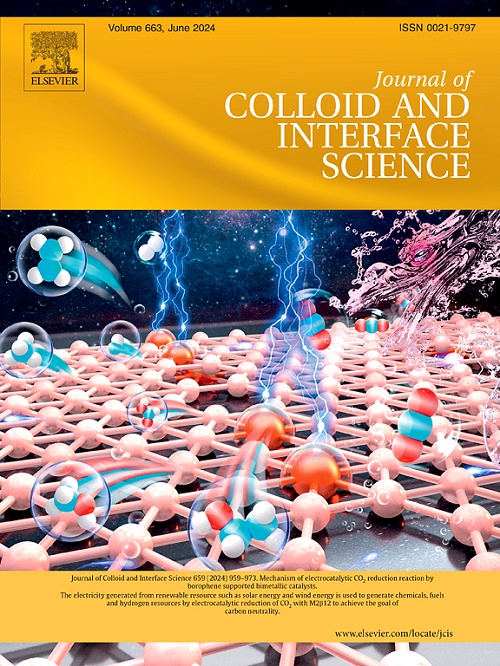Multifunctional Janus nanofibrous membrane with unidirectional water transport and pH-responsive color-changing for wound dressing
IF 9.4
1区 化学
Q1 CHEMISTRY, PHYSICAL
引用次数: 0
Abstract
Chronic wounds often produce a significant volume of exudate, posing a substantial obstacle to healing. Consequently, there is a pressing demand for a versatile dressing capable of effectively managing exudate in chronic wounds. In this context, a Janus smart dressing is proposed, featuring unidirectional water transport and a pH-responsive color-changing for exudate management and wound monitoring. The dressing’s mechanisms for unidirectional water transport and color changing are elucidated. The Janus dressing consists of a polyacrylonitrile (PAN)/sodium polyacrylate (SPA)/anthocyanin (An) hydrophilic layer with antioxidant and pH-sensitive functions and a poly (3-hydroxybutyrate-co-3-hydroxyvalerate) (PHBV) hydrophobic layer, enabling unidirectional exudate drainage without reverse osmosis. Studies indicate that the Janus dressing exhibits excellent air permeability, moisture permeability, mechanical properties, cytocompatibility, and antioxidant performance while promptly responding to color variations in solutions of varying pH levels. In vivo studies demonstrated the excellent wound healing ability of Janus PHBV-PAN/SPA/An membrane. Consequently, this study provides a promising solution to develop wound dressings that can effectively manage excessive wound exudate and dressing changes.

用于伤口敷料的多功能 Janus 纳米纤维膜,具有单向水传输和 pH 值响应变色功能。
慢性伤口通常会产生大量渗出物,对伤口愈合造成极大的阻碍。因此,人们迫切需要一种能够有效处理慢性伤口渗出物的多功能敷料。为此,我们提出了一种 Janus 智能敷料,它具有单向水分传输和 pH 值响应变色功能,可用于渗出物管理和伤口监测。本文阐明了该敷料的单向水分传输和变色机制。Janus 敷料由具有抗氧化和 pH 值敏感功能的聚丙烯腈 (PAN) / 聚丙烯酸钠 (SPA) / 花青素 (An) 亲水层和聚(3-羟基丁酸-co-3-羟基戊酸)(PHBV) 疏水层组成,无需反渗透即可实现单向渗液引流。研究表明,Janus 敷料具有出色的透气性、透湿性、机械性能、细胞相容性和抗氧化性能,同时能对不同 pH 值溶液中的颜色变化迅速做出反应。体内研究表明,Janus PHBV-PAN/SPA/An 膜具有出色的伤口愈合能力。因此,这项研究为开发能有效控制伤口渗液过多和敷料更换的伤口敷料提供了一种前景广阔的解决方案。
本文章由计算机程序翻译,如有差异,请以英文原文为准。
求助全文
约1分钟内获得全文
求助全文
来源期刊
CiteScore
16.10
自引率
7.10%
发文量
2568
审稿时长
2 months
期刊介绍:
The Journal of Colloid and Interface Science publishes original research findings on the fundamental principles of colloid and interface science, as well as innovative applications in various fields. The criteria for publication include impact, quality, novelty, and originality.
Emphasis:
The journal emphasizes fundamental scientific innovation within the following categories:
A.Colloidal Materials and Nanomaterials
B.Soft Colloidal and Self-Assembly Systems
C.Adsorption, Catalysis, and Electrochemistry
D.Interfacial Processes, Capillarity, and Wetting
E.Biomaterials and Nanomedicine
F.Energy Conversion and Storage, and Environmental Technologies

 求助内容:
求助内容: 应助结果提醒方式:
应助结果提醒方式:


